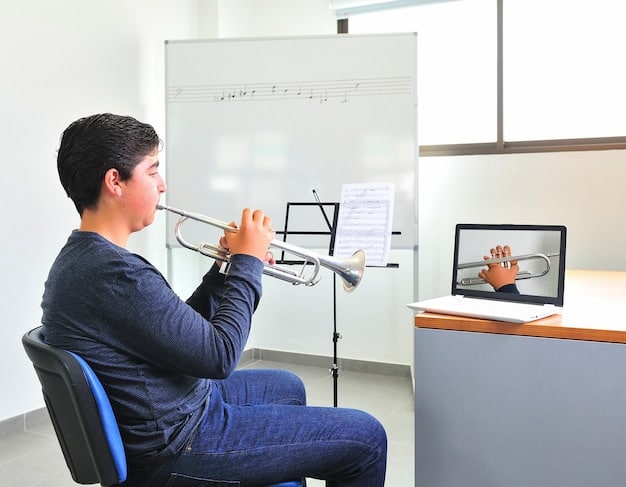K-Pop Vocal Techniques: Appreciating Unique Artist Styles

K-Pop vocal techniques encompass a wide range of methods, from breath control and resonance to stylistic choices, which allow artists to create distinct sounds; understanding these techniques enhances appreciation for the unique vocal styles of individual K-Pop performers.
Dive into the fascinating world of K-Pop and discover the unique vocal techniques that set your favorite artists apart. From powerful high notes to delicate harmonies, understanding these nuances will deepen your appreciation for the artistry involved in creating K-Pop’s signature sound.
Exploring K-Pop Vocal Techniques
K-Pop isn’t just about catchy tunes and synchronized dances; it’s also about incredible vocal talent and highly developed techniques. To truly appreciate K-Pop, it’s essential to understand the building blocks that create its unique sound. Let’s take a deeper look into the fundamental techniques.
Breath Control and Support
One of the most crucial aspects of any vocal performance is breath control. K-Pop idols undergo rigorous training to master diaphragmatic breathing, which allows them to sustain notes, control dynamics, and deliver impactful performances, even while dancing energetically.
Resonance and Placement
Resonance refers to the amplification and modification of sound within the vocal tract. K-Pop vocalists learn to manipulate resonance to create different timbres and vocal colors. Proper placement ensures the sound is focused and projected effectively, adding power and clarity to their singing.
- Diaphragmatic Breathing: Essential for sustained notes and vocal power.
- Vocal Placement: Focusing the sound for clarity and projection.
- Resonance Manipulation: Creating different vocal colors and timbres.
Breath control and resonance are the foundational elements upon which all other K-Pop vocal techniques are built. Mastering these basics allows artists to explore a wider range of styles and expressiveness, contributing to the genre’s diverse soundscape.

Identifying Unique Vocal Styles
Beyond the fundamental techniques, what truly makes a K-Pop artist stand out is their unique vocal style. These styles are shaped by individual preferences, vocal ranges, and the specific demands of their group’s music. Understanding these styles allows for a deeper connection with the artists’ performances.
Main Vocalists vs. Sub-Vocalists
In most K-Pop groups, there’s a clear distinction between main vocalists and sub-vocalists. Main vocalists often handle the most technically demanding parts, showcasing their vocal range and control. Sub-vocalists contribute harmonies, add texture, and support the main vocalists during performances.
Vocal Color and Tone
Each singer possesses a unique vocal color, determined by the physical characteristics of their vocal cords and the way they manipulate their vocal tract. This vocal color, combined with their preferred tone, contributes significantly to their individual style. Some artists have a bright, clear tone, while others have a deeper, more soulful sound.
- Harmonization Techniques: Supporting the main melody with rich vocal layers.
- Ad-libs and Improvisation: Adding personal flair and spontaneity to songs.
- Emotional Delivery: Conveying the song’s message with sincerity and passion.
By recognizing the subtle differences in vocal color, tone, and role within a group, listeners can begin to appreciate the individuality and artistry of each K-Pop vocalist. These stylistic nuances contribute to the richness and variety of the genre.
The Influence of Vocal Training
Rigorous vocal training is a cornerstone of the K-Pop industry, shaping the capabilities and styles of its artists. This training encompasses various aspects, from basic technique to stylistic refinement, ensuring that K-Pop vocalists are well-equipped to handle the demands of their careers.
Formal Vocal Lessons
Most K-Pop idols undergo extensive formal vocal lessons with experienced coaches. These lessons focus on developing proper technique, expanding vocal range, improving breath control, and refining vocal tone. The training is often tailored to the individual’s strengths and weaknesses, helping them reach their full potential.
Performance Coaching
Beyond vocal technique, K-Pop trainees also receive performance coaching, which focuses on stage presence, charisma, and connecting with the audience. This coaching helps them develop their own unique style and deliver captivating performances that leave a lasting impression.
- Range Expansion Exercises: Increasing vocal flexibility and high notes.
- Diction and Pronunciation: Ensuring clarity and proper delivery of lyrics.
- Endurance Training: Maintaining vocal stamina during demanding performances.
The intensive vocal training prevalent in the K-Pop industry plays a vital role in shaping the skills and styles of its artists. It cultivates not only technical proficiency but also the artistry and individuality that make K-Pop vocalists so compelling.

Analyzing Vocal Techniques of Iconic K-Pop Artists
To truly understand K-Pop vocal techniques, it’s helpful to analyze the styles of some of the most iconic artists in the industry. By examining their approaches to singing, we can gain a deeper appreciation for the diversity and artistry within K-Pop.
Taeyeon (Girls’ Generation)
Taeyeon is renowned for her powerful vocals, exceptional range, and emotive delivery. Her ability to effortlessly transition between delicate melodies and soaring high notes has made her one of the most respected vocalists in K-Pop. Her strength lies in her ability to convey raw emotion through her vocal performance, connecting deeply with listeners.
Jungkook (BTS)
Jungkook is celebrated for his versatile vocals, smooth tone, and impressive control. He is capable of handling a wide range of genres and styles and consistently delivers polished and impactful performances. Jungkook masters a technique that allows for complex harmonies and a strong stage presence.
- Vocal Agility: The ability to navigate complex melodies with ease.
- Belting Technique: Projecting powerful high notes with support and control.
- Vibrato Control: Adding warmth and depth to sustained notes.
Examining the vocal techniques of iconic K-Pop artists like Taeyeon and Jungkook reveals the diverse approaches and styles that contribute to the genre’s rich tapestry. Their mastery of vocal technique, combined with their unique artistic expression, has solidified their positions as influential figures in the K-Pop world.
The Role of Technology in Vocal Production
In the modern K-Pop landscape, technology plays a significant role in vocal production, influencing both the recording process and the final sound of the music. Understanding these technological interventions is crucial for a comprehensive understanding of K-Pop vocal techniques.
Auto-Tune and Vocal Effects
Auto-tune is a common tool used in K-Pop production to correct pitch and enhance vocal harmonies. While it can be used subtly to polish performances, it can also be employed more heavily to create a distinctive, stylized sound. Other vocal effects, such as reverb, delay, and chorus, are frequently used to add depth, texture, and atmosphere to vocal tracks.
Vocal Layering and Mixing
Vocal layering involves recording multiple takes of the same vocal part and combining them to create a fuller, richer sound. This technique is often used in K-Pop to enhance harmonies and add power to choruses. Skilled mixing engineers carefully balance these layers, ensuring that each vocal part is clear and audible.
- Dynamic Range Compression: Balancing the volume levels for a polished sound.
- Equalization (EQ): Shaping the tonal characteristics of the vocals.
- Pitch Correction Software: Refining vocal performances for accuracy.
Technology has become an indispensable element of K-Pop vocal production, shaping the way vocals are recorded, manipulated, and presented. While debates persist about the appropriate use of these tools, their influence on the sound of K-Pop is undeniable.
The Future of K-Pop Vocal Techniques
As K-Pop continues to evolve and expand its global reach, the vocal techniques employed by its artists are also likely to adapt and innovate. Exploring potential future trends can provide valuable insights into the continued development of this dynamic art form.
Incorporating Global Influences
K-Pop is increasingly incorporating influences from other genres and cultures around the world. This trend may lead to the adoption of new vocal techniques and styles, blending traditional K-Pop approaches with global sounds. Expect to see experimentation with diverse vocal styles creating unique cross-genre sounds.
Emphasis on Authenticity and Individuality
As audiences become more discerning, there may be a growing emphasis on authenticity and individuality in K-Pop vocal performances. Artists may prioritize showcasing their unique vocal colors and expressive abilities, rather than conforming to standardized techniques. This shift will result in a trend of vocalists with unique styles and expressive qualities.
- Vocal Technology Integration: Experimenting with new tools for vocal enhancement.
- Genre Blending: Merging K-Pop vocals with other musical styles.
- Cross-Cultural Collaboration: Incorporating diverse global techniques.
The future of K-Pop vocal techniques promises to be an exciting period of innovation, experimentation, and adaptation. As the genre continues to evolve, vocalists will likely push boundaries, embrace new influences, and prioritize authenticity, creating a dynamic and compelling soundscape.
| Key Point | Brief Description |
|---|---|
| 🎤 Vocal Techniques | Diaphragmatic breathing, resonance, and vocal placement. |
| 🎶 Unique Styles | Vocal color, tone, and role in group dynamics. |
| 🎧 Technology | Auto-tune, vocal layering, and mixing influence final sound. |
| 🌟 Future Trends | Global influences, authenticity, and technology integration. |
K-Pop Vocal Techniques: FAQs
▼
Diaphragmatic breathing, or belly breathing, is a technique where you breathe deeply from your diaphragm, allowing for better breath control and vocal support, crucial for K-Pop vocalists during intense performances.
▼
Vocal training helps K-Pop artists expand their vocal range, improve their control, and develop unique stylistic elements, ensuring they can deliver top-notch performances consistently.
▼
Technology such as Auto-Tune, vocal layering, and mixing are commonly used in K-Pop to enhance vocals, correct pitch, and create a polished, stylized sound that meets industry standards.
▼
Main vocalists typically handle the most challenging vocal parts and showcase range, while sub-vocalists often provide harmonies and support, adding texture and depth to the songs.
▼
Vibrato adds warmth and depth to sustained notes in K-Pop singing, demonstrating control and artistry. It enhances the emotional impact of the performance by adding richness to the vocal tone.
Conclusion
Understanding the vocal techniques employed by K-Pop artists offers a deeper appreciation for their artistry and dedication. From breath control and resonance to unique stylistic choices and technological enhancements, the world of K-Pop vocals is rich and diverse. As the genre continues to evolve, these techniques will undoubtedly shape its future, defining the sounds and styles we come to love.





